Weed control on sand dunes
About weed control
Exotic species such as kikuyu grass, buffalo grass and South African ice plant dominate many Northland dunes. These weed species actively invade foredunes and are not as effective as the native sand binders spinifex and pingao in repairing stormdamaged frontal dunes.
When undertaking a dune restoration project it is very important to plan and maintain a weed control programme. If this is not done then all the effort of planting can be wasted!
These guidelines give some recommendations for weed control on foredune and backdune areas. This includes different methods that can be used, and advice for successful weed control. Please contact the Northland Regional Council for specific weed control and dune restoration advice on Freephone 0800 002 004.
Why native plants work best
While dunes do not stop wave erosion, they provide a natural self-repairing buffer to absorb the impacts of storm events. Dune vegetation plays an important role in natural beach and dune dynamics and it is critical to have the appropriate native sandtrapping vegetation, particularly spinifex and pingao, on the seaward face of the dune.
Exotic species such as kikuyu and ice plant often colonise foredunes but are not as effective as the native sand-binders spinifex and pingao at repairing storm-damaged frontal dunes.
On more landward backdune sites, many exotic species, including garden escapees often form a dense cover of vegetation that competes with native backdune plants and invades foredunes.
For more information see the regional council leaflet Caring for Northland's Dunes.
Which plants are weeds?
- It is essential to become familiar with which plants are natives and which are exotic weeds, so you can assess the weediness of your dunes and target the right plants.
- Kikuyu is a well-known and wide-spread weed. It should be one of the first weeds you target as it's highly invasive.
- Other common weeds on Northland dunes include buffalo grass, purple groundsel, exotic ice plant and marram (which of often confused with spinifex, a native).
- If in doubt, contact the Northland Regional Council for advice on what's a weed and what's not.
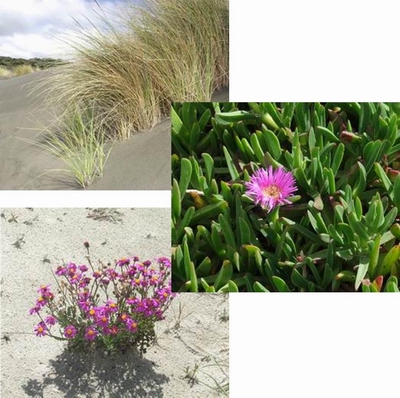
Weed control options
Depending on the density of weeds and area of dunes to be restored there are several weed control methods to choose from:
Hand weeding
- Labour intensive requiring constant vigilance but is suitable for some weeds, sensitive sites or small infestations.
- Weeds with the potential to set root from fragments or germinate from any seed attached will require removal from the site.
- If this method is used it is very important to check the area regularly and remove weeds before they spread.
Application of herbicides
- A practical method over large areas of dunes.
- Most commonly used herbicides on foredunes are:
- The broad-spectrum herbicide glyphosate (e.g. Roundup™) which controls weeds like grasses, broadleaf herbaceous species and South African ice plant;
- The grass-selective herbicide haloxyfop (e.g. Gallant®) which controls kikuyu, buffalo grass and most other grasses while leaving other plants unaffected; and
- Clopyralid (eg. Versatill™) controls the daisy family (Asteraceae and Compositae) while not affecting any of the native dune species.
- The most common method of application of herbicide on foredunes is knapsack spraying. Weed-wipers can also be a good option as they allow for more precise application.
Mechanical site preparation
- This method is often used on a new dune restoration site.
- Good for large-scale removal of heavy weed cover where capping material such as clay or gravel needs to be removed.
- Involves removing dense exotic vegetation cover by machines to create a ‘clean' site to allow planting of natives.
- Spraying of the weed cover is carried out before clearing of the vegetation and reshaping.
- These cleared and reshaped sites tend to have significantly less weed invasion than similar sites prepared by hand-clearing methods.
- Follow-up weed control is still required, usually involving knapsack spraying of herbicides as vigorous grasses appear.
- Contact the Northland Regional Council before undertaking any earthworks to check whether the work you plan requires a resource consent.
Using tolerant plants as spray buffers
- Increasingly, non-grass indigenous species such as pingao, wiwi and pohuehue are planted as a buffer between backdune sites and spinifex zones on foredunes.
- Effective in high use areas where exotic grasses can spread readily from mown reserves into adjacent restored foredunes with spinifex.
- Regular herbicide spraying of a 30-50 cm strip along the boundary between foredune vegetation and mown grass reserve is required to prevent invasion.
Dense planting of natives
- Plant natives at high density to encourage canopy cover, to reduce open spaces where weeds will become established.
- Use fertilisers to boost growth of natives to provide dense cover.
Weed control on foredunes using herbicides
- Use Glyphosate for effective control of both exotic grasses and herbaceous weeds.
- Lower rates of chemical than recommended on the label are likely to give effective weed control – test on a small area first to confirm the effectiveness for new sites and weed species before committing to larger areas.
- Careful use of knapsack sprayer with a fan jet at low pressure will allow for spraying of weeds around established native plants and help avoid overspray. A plastic bucket is an effective shield to avoid spray drift on plants.
- Where there's a dense cover of exotic grass and weeds, it's unlikely one application of herbicide will kill all the weeds, especially when spraying around native plants. Spot spraying of scattered weeds that are alive 2-4 months after the initial weed control will be essential to prevent re-invasion of the foredune.
- Regular inspections are required to ensure timely weed control is carried out before weeds overtop natives.
Weed control on backdunes using herbicides
- For backdune sites with pohuehue or other woody ground cover native species dominated by rank exotic grasses, use Haloxyfop at or near label rates for control of exotic grasses.
- The lower rates of Haloxyfop of both half and three-quarter the suggested label rates are equally effective as the full label rate at killing both kikuyu and buffalo grass on backdunes.
- Haloxyfop does not affect pohuehue so application is fast and effective.
- Within 3 months follow-up spot spraying with Haloxyfop will be required for occasional exotic grass plants missed during initial treatment.
- Haloxyfop will not control herbaceous/dicot weeds so these will require spot spraying with Glyphosate or hand-pulling (or clopyralid for daisy species).
- Woody weeds like gorse, blackberry and boneseed will require combinations of hand cutting, and swabbing or spraying with brush killer herbicides.
- Contact the Northland Regional Council for removal techniques and advice on suitable replacement plants.
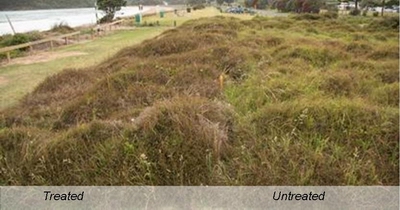 Spray trials - pohuehue sprayed with haloxyfop on left, untreated on right.
Spray trials - pohuehue sprayed with haloxyfop on left, untreated on right.
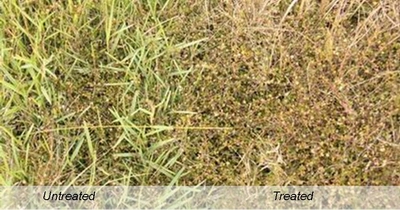 Spray trials - pohuehue sprayed with haloxyfop on right, untreated on left.
Spray trials - pohuehue sprayed with haloxyfop on right, untreated on left.
Tips for successful weeding on dunes
- Regularly check restored and planted dunes for invasion of weeds:
- Removal of small scattered weeds is easy;
- Dense weed growth is difficult to manage and results in loss of natives.
- Use a range of methods to suit your site and resources – hand pulling, grubbing, herbicide spraying, weed-wiper, dense planting of natives.
- Know the best time to apply herbicides:
- Spray plants when they are actively growing – spring to autumn;
- Spray after rain has washed dust and salt off leaves.
- Use a marker dye to make sure you don't miss any weeds or spray areas twice.
- When using contractors or volunteers clearly identify which plants need to be removed and which plants are native.
- Follow up all weed control with regular inspections to remove any regrowth before it becomes a problem!
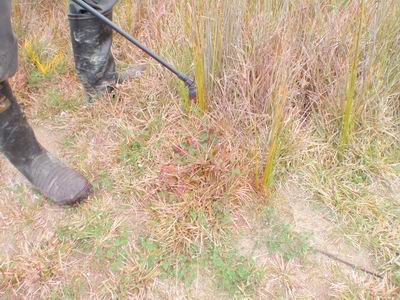 Avoid spraydrift by spraying low, and use a marker dye so you know what you’ve sprayed.
Avoid spraydrift by spraying low, and use a marker dye so you know what you’ve sprayed.
Suggested planting pattern on restored site
- When restoring a site, careful placement of plant species can create a buffer between an exotic grass lawn and native sandbinding species.
- Plant a zone of sedge, rush and woody ground cover species between the mowed lawn and the foredune face dominated by spinifex.
- The grass-selective herbicide Haloxyfop (e.g. Gallant®) can then be sprayed over non-grass natives to control invasion of exotic grasses.
- Maintain a 30-50 cm wide sprayed zone between the exotic lawn and the native planting zone to prevent invasion of vigorously spreading exotic grasses.
- Regular hand removal and/or spot-spraying of weeds with herbicide as they appear will be required to maintain a dominant cover of native plants on the dune.
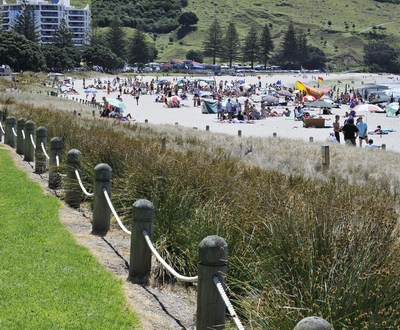 An example of the suggested spraying and planting pattern to prevent the spread of kikuyu onto dunes.
An example of the suggested spraying and planting pattern to prevent the spread of kikuyu onto dunes.

Warning/Disclaimer
The information on selection, rates and use of herbicides in this brochure is based on information reviewed from a range of sources, but must be assessed on a case by case basis. It is recommended that users of herbicides follow manufacturers' instructions at all times.
Please contact the Northland Regional Council before undertaking any dune restoration work. Any work must have the permission of the land owner e.g. the local district council for work on a council reserve. Please contact the regional council or your district council if you are not sure who the landowner is.
Accordingly, the council will not be liable on any ground for loss, claim, liability or expense arising from or due to errors, omissions or advice provided within this brochure or from the use of herbicides or consequences arising from the use of herbicides.
More information
For more information please contact the Northland Regional Council on 0800 002 004.
